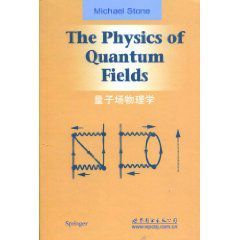內容簡介
 量子場物理學
量子場物理學The book does not cover as much ground as some texts. This is because I have tried to concentrate on the basic conceptual issues that many students find difficult. For a computation-method oriented course an instructor would probably wish to suplement this book with a more comprehensive and specialized text such as Peskin and Schroeder An Introduction to Quantum Field Theory, which is intended for particle theorists, or perhaps the venerable Quantum Theory of Many-Particle Systems by Fetter and Walecka.
作者簡介
作者:(美國)斯通(Michael Stone)
圖書目錄
Preface
1 Discrete Systems
1.1 One-Dimensional Harmonic Crystal
1.1.1 Normal Modes
1.1.2 Harmonic Oscillator
1.1.3 Annihilation and Creation Operators for Normal Modes
1.2 Continuum Limit
1.2.1 Sums and Integrals
1.2.2 Continuum Fields
2 Relativistic Scalar Fields
2.1 Convcntions
2.2 The Klein-Gordon Equation
2.2.1 Relativistic Normalization
2.2.2 An Inner Product
2.2.3 Complex Scalar Fields
2.3 Symmetries and Noether's Theorem
2.3.1 Internal Symmetries
2.3.2 Space-Time Symmetries
3 Perturbation Theory
3.1 Interactions
3.2 Perturbation Theory
3.2.1 Interaction Picture
3.2.2 Propagators and Time-Ordered Products
3.3 Wick's Theorem
3.3.1 Normal Products
3.3.2 Wick's Theorem
3.3.3 Applications
4 Feynman Rules
4.1 Diagrams
4.1.1 Diagrams in Space-time
4.1.2 Diagrams in Momentum Space
4.2 Scattering Theory
4.2.1 Cross-Sections
4.2.2 Decay of an Unstable Particle
5 Loops, Unitarity, and Analyticity
5.1 Unitarity of the S Matrix
5.2 The Analytic S Matrix
5.2.1 Origin of Analyticity
5.2.2 Unitarity and Branch Cuts
5.2.3 Resonances, Widths, and Lifetimes
5.3 Some Loop Diagrams
5.3.1 Wick Rotation
5.3.2 Feynman Parameters
5.3.3 Dimensional Regularization
6 Formal Developments
6.1 Gell-Mann Low Theorem
6.2 Lehmann-Kaillen Spectral Representation
6.3 LSZ Reduction Formulae
6.3.1 Amputation of External Legs
6.3.2 In and Out States and Fields
6.3.3 Borcher's Classes
7 Fermions
7.1 Dirac Equation
7.2 Spinors, Tensors, and Currents
7.2.1 Field Bilinears
7.2.2 Conservation Laws
7.3 Holes and the Dirac Sea
7.3.1 Positive and Negative Energies
7.3.2 Holes
7.4 Quantization
7.4.1 Normal and Time-Ordered Products
8 QED
8.1 Quantizing Maxwell's Equations
8.1.1 1 Hamiltonian Formalism
8.1.2 Axial Gauge
8.1.3 Lorentz Gauge
8.2 Feynman Rules for QED
8.2.1 Moiler Scattering
8.3 Ward Identity and Gauge Invariance
8.3.1 The Ward Identity
8.3.2 Applications
9 Electrons in Solids
9.1 Second Quantization
9.2 Fermi Gas and Fermi Liquid
9.2.1 One-Particle Density Matrix
9.2.2 Linear Response
9.2.3 Diagram Approach
9.2.4 Applications
9.3 Electrons and Phonons
10 Nonrelativistic Bosons
10.1 The Boson Field
10.2 Spontaneous Symmetry Breaking
10.3 Dilute Bose Gas
10.3.1 Bogoliubov Transfomation
10.3.2 Field Equations
10.3.3 Quantization
10.3.4 Landau Criterion for Superfiuidity
10.3.5 Normal and Superfiuid Densities
10.4 Charged Bosom
10.4.1 Gross-Pitaevskii Equation
10.4.2 Vortices
10.4.3 Connection with Fluid Mechanics
11 Finite Temperature
11.1 Partition Functions
11.2 Worldlines
11.3 Matsubara Sums
12 Path Integrals
12.1 Quantum Mechanics of a Particle
12.1.1 Real Time
12.1.2 Euclidean Time
12.2 Gauge Invariance and Operator Ordering
12.3 Correlation Functions
12.4 Fields
12.5 Gaussian Integrals and Free Fields
12.5.1 Real Fields
12.5.2 Complex Fields
12.6 Perturbation Theory
13 Functional Methods
13.1 Generating Functionals
13.1.1 Effective Action
13.2 Ward Identities
13.2.1 Goldstone's Theorem
14 Path Integrals for Fermions
14.1 Berezin Integrals
14.1.1 A Simple Supersymmetry
14.2 Fermionic Coherent States
14.3 Superconductors
14.3.1 Effective Action
15 Lattice Field Theory
15.1 Boson Fields
15.2 Random Walks
15.3 Interactions and Bose Condensation
15.3.1 Rotational Invariance
15.4 Lattice Fermions
15.4.1 No Chiral Lattice Fermions
16 The Renormailzation Group
16.1 Transfer Matrices
16.1.1 Continuum Limit
16.1.2 Two-Dimensional Ising Model
16.2 Block Spins and Renormalization Group
16.2.1 Correlation Functions
17 Fields and Renormalization
17.1 The Free-Field Fixed Point
17.2 The Gaussian Model
17.3 General Method
17.4 Nonlinear o Model
17.4.1 Renormalizing
17.4.2 Solution of the RGE
17.5 Renormalizing
18 Large N Expansions
18.1 O(N) Linear a-Model
18.2 Large N Expansions
18.2.1 Linear vs. Nonlinear σ-Models
A Relativistic State Normalization
B The General Commutator
C Dimensional Regularization
C.I Analytic Continuation and Integrals
C.2 Propagators
D Spinors and the Principle of the Sextant
D.1 Constructing the λ-Matrices
D.2 Basic Theorem
D.3 Chirality
D.4 Spin(2N), Pin(2N), and SU(N) C SO(2N)
E Indefinite Metric
F Phonons and Momentum
G Determinants in Quantum Mechanics
Index
